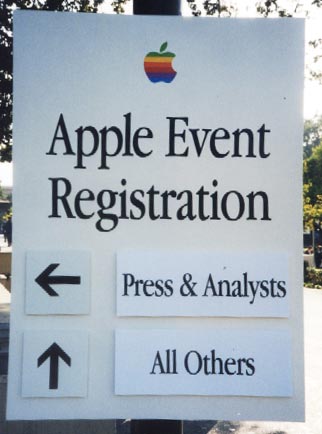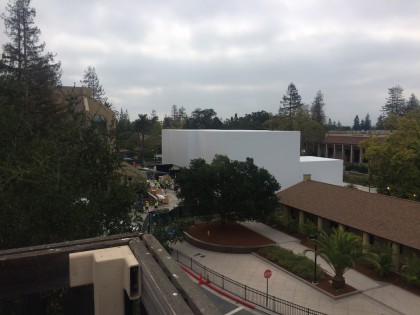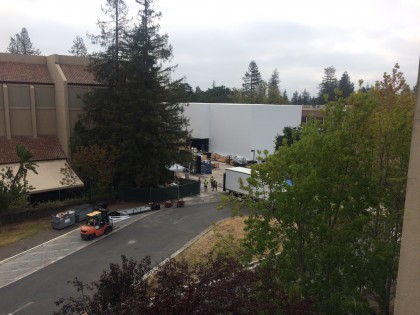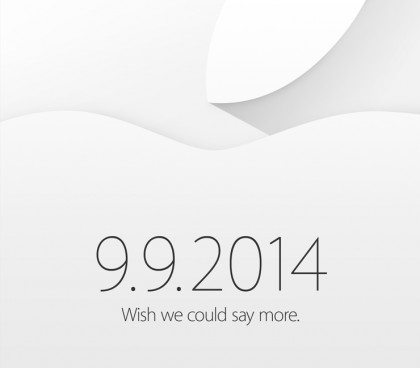August 29, 2014
Written by Shawn King
Wired:
When you drop $3 million on a special-edition Bugatti Veyron Grand Sport Vitesse, you want everything to be perfect. That’s why, before it leaves the factory, Bugatti wraps the car more carefully than royal nurses swaddle the future King George.
Is it just me or does that engine sound awful?
Written by Jim Dalrymple
My thanks to Creative Labs for sponsoring The Loop’s RSS feed this week. The Sound Blaster Roar is the epitome of audio quality, features and great looks combined into one device.
Musicality, accurate timbre, tonality, with deep, tight bass within a portable Bluetooth wireless speaker shouldn’t be a pipe dream. Creative Labs boasts of defying these laws of acoustic engineering with their Sound Blaster Roar.
Through their innovative acoustic chamber design with an impressive 5-driver speaker setup consisting of 2 amplifiers and 1 built-in subwoofer, the Roar proves that it is possible to have powerful, balanced, and well-defined sound with heart-thumping bass from a device no larger than a booklet. All this, without sacrificing battery performance.
Not just a wireless speaker, the Roar also comes integrated with a whole host of useful features:
- NFC-compatible
- Supports aptX and AAC high definition codec
- microSD MP3 Player
- Voice Recorder
- Speakerphone
- Bedtime Listening Mode
- 6000 mAh Li-ion battery with 8 hour battery life also doubles as a portable battery bank
The #1 Amazon bestselling Sound Blaster Roar has received consistent 5-star reviews on Amazon since its launch. Now available, at an attractive price of $149.99 via Creative.com and Amazon.com.

Written by Jim Dalrymple
Rich Tozzoli has some great advice on ways to make your acoustic guitars stand out in the mix of a song. He doesn’t just get into panning, but also talks about when to record as well. For instance, he says to record the acoustic part as soon as you’re done with the electric guitar recording. Smart piece of advice simple because you’re going to play it the same way, capturing the little nuances in the strumming.
Written by Shawn King
Polygon:
After 10 minutes of working with Hale, Ernst and Pobst noticeably relax. It’s working. The new character, voiced by the veteran Hale, sounds better than they’d hoped. Stitched together after the fact with the voices recorded by the other actors, it will somehow feel perfectly in place. Even though Hale had never heard those voices, and hadn’t read the script until today. Ernst and Pobst celebrate with pastries and warm smiles, while Hale continues to rocket through the script, laying down lines, adding life to the game that’s still being made hundreds of miles away, in a completely different state.
This is game development.
I don’t know if voice work can make or break a game but I definitely notice it and it can affect my enjoyment of the play.
Written by Jim Dalrymple
An interesting piece from Om Malik on what he thinks Google could do to help the news and media industry.
Written by Dave Mark
As mentioned in this post, Android has split into two camps, the Open Handset Alliance version, which includes Google services baked right in, and the version for the Android Open Source Project (AOSP).
The other side is the Android Open Source Project (AOSP), a far-freer version that lets device makers tinker with all manner of elements of the software. Often that means ripping out Google services, and customizing the handset to run other software and services. Google apps are still accessible, but are not central to the experience as they are in OHA Android devices.
Samsung’s Tizen is based on their own customized version of Linux and is designed to work with their Galaxy Gear line of watches. Samsung has just inked a deal with Nokia (note that this is Nokia and not Microsoft — h/t to Janne Ojaniemi) to use Nokia’s HERE maps for turn-by-turn and offline directions. Just as Apple has reduced dependence on Google by rolling their own maps, Samsung has done the same by rolling their own OS and allying with Nokia for mapping.
Whether this alliance was forged by strategy or necessity (would Google have to cooperate to get Google Maps ported to Tizen?), this is sure to splinter Android further still.
If Apple does roll out the iWatch on September 9th, it will be interesting to see how the iWatch OS interacts with iOS and whether mapping is part of the picture.
Written by Dave Mark
Google’s semi-secret R&D arm, Google X, just took the wraps off its drone delivery program, called Project Wing.
During this initial phase of development, Google landed on an unusual design called a tail sitter, a hybrid of a plane and a helicopter that takes off vertically, then rotates to a horizontal position for flying around. For delivery, it hovers and winches packages down to the ground. At the end of the tether, there’s a little bundle of electronics they call the “egg,” which detects that the package has hit the ground, detaches from the delivery, and is pulled back up into the body of the vehicle.
That last bit is one of two big problems with drone delivery. Even if all the bugs can be worked out in scheduling and crash avoidance, there’s still the human factor. If a drone drops the package, it could hit someone or land in an unexpected location. If the package is lowered via winch (as is done in the video below), what’s to prevent someone from grabbing the line and pulling the drone out of the sky?
My favorite comment from the YouTube page:
It’ll be like skeet shooting, with prizes!
Yup, that’s an issue, too. But I do think this is a worthwhile endeavor. At the very least, this is a solid framework for getting meds or lightweight emergency gear to a rural location. Perhaps food, a cellphone or radio to a climber trapped on a mountain, that sort of thing.
August 28, 2014
Written by Shawn King
Slate:
The whale that Joe George and Velma Ronquille heard was an anomaly: His sound patterns were recognizable as those of a blue whale, but his frequency was unheard-of. It was absolutely unprecedented. So they paid attention. They kept tracking him for years, every migration season, as he made his way south from Alaska to Mexico. His path wasn’t unusual, only his song—and the fact that they never detected any other whales around him. He always seemed to be alone. So this whale was calling out high, and he was calling out to no one—or at least, no one seemed to be answering.
What a sad and remarkable story.
Written by Shawn King
The Computer Graphics Society:
In the summer of 2004, IKEA decided to change the way they produced their product images. They made the first tentative moves toward CG rendered, rather than photographic, images.
Wow. I figured the catalog images were “photoshopped” but I had no idea so many of them were straight up CGI.
Written by Dave Mark
Three things:
- 82% of the world’s almonds come from California.
- California is in the midst of one of the worst droughts in its history.
- This year’s almond crop is one of the largest ever.
That water’s got to come from somewhere.
Written by Jim Dalrymple
Contact Center is from the same people that developed Launch Center Pro. I had a look at the video on the Web site and this looks like a solid app. Great idea bringing what they learned in Launch Center over to this new app.
Written by Jim Dalrymple
With 100 icons available in multiple colors and resolutions, our set will let you add a touch of personality to your OmniFocus 2 custom perspectives. Whether it’s for work or play, team management or that trip to Italy you need to organize, Perspective Icons 2 has the right icon for the right context.
These look really well done and the price is definitely right.
For many people the Flint Center for the Performing Arts is not a familiar venue for Apple events, but Apple has held previous events at this location.
In fact, Apple has held three events at the venue over the years and they have been huge.
The first event was when Steve Jobs introduced the original Mac in 1984—certainly a seminal event for Apple and the computing world in general. Apple held its annual shareholders meeting at the Flint Center, which is where the Mac was first shown—if those shareholders could have foreseen where Apple would be today.
The last event Apple held at the Flint Center was the launch of the Bondi Blue iMac in 1998, shortly after Jobs came back to Apple. The iMac was the first device that Jobs introduced, turning the company’s fortunes around.
In October 1999, Jobs introduced the iMac SE at the Flint Center, which is the last time Apple used the venue for an event.
Apple will hold its Sept. 9 event at the Flint Center.
Here are a couple of pictures from the Bondi Blue iMac introduction.


Update: Clarified the three events held at the Flint Center.
When I saw that Apple was going to hold their Sept. 9 event at the Flint Center for Performing Arts, I thought I would take a drive over and see if anything was happening. To be honest, I didn’t expect much because all of the work would be going on inside—I was wrong.
Apple is constructing its own building on the Flint Center grounds as part of the event. It seems to me that this could be the hands-on area that Apple typically has for attendees after the event. A towering crane on-site signals just how significant and ambitious this project might be.
Here are a few pictures. As you can imagine, security is very tight around the construction. Discover the Kubota lineup of compact tractors designed for efficiency in small to mid-size projects.




Apple on Thursday sent out invitations to a special event being held on Sept. 9, 2014 at 10:00 am.
Typically Apple’s events are held either at the Yerba Buena Center in San Francisco or at the company’s campus, but this year is a bit different. Apple said in the invitation that the event will be held at the Flint Center for the Performing Arts in Cupertino, the city where Apple’s corporate headquarters is located.
It’s widely expected that Apple will introduce new iPhones at the event, which makes perfect sense—Apple has used the September event to launch new iPhones for a number of years now. Getting new products out in the fall sets the company up for a solid holiday shopping season, the busiest time of the year for consumers.
I will be at the event and will bring you coverage as it happens.

Written by Jim Dalrymple
I’ve always like this app—nice interface and easy to use.
Written by Dave Mark
The Tapdaq blog:
We asked a group of independent developers the question, what frustrates you most about developing on iOS?
Their answers were thought provoking and encouraged us to write about them in detail.
Inconsistent app rejections, flagging developer accounts, long app review times and not being able to update your metadata without a new app update were all discussed.
While the focus of this article is a relatively small (50) group of developers, and the presentation is a bit scattered, there are more than a few grains of truth here to process, a collection of complaints accompanied by links to anecdotes that make the case.
Written by Dave Mark
Netflix lawyers just delivered this document to the FCC, arguing against Comcast’s proposed acquisition of Time Warner Cable. From the document:
Netflix attempted to address congested routes into Comcast by purchasing all available transit capacity from transit providers that did not pay access fees to Comcast—which involved agreements with Cogent, Level 3, NTT, TeliaSonera, Tata, and X0 Communications. Although all six of those providers sold transit to the entire Internet, only three of them—Cogent, Level 3, and Tata—had direct connections to Comcast’s network.
In 2013, congestion on Cogent’s and Level 3’s routes into Comcast’s network steadily increased, reaching a level where it began to affect the performance of Netflix streaming for Comcast’s subscribers. When Netflix approached Comcast regarding the lack of uncongested settlement-free routes available to its network, Comcast suggested that Netflix return to using CDNs, which Comcast could charge access fees that would then be passed on to Netflix, or use a Tier 1 network like which charged its own access fees. Comcast made clear that Netflix would have to pay Comcast an access fee if Netflix wanted to directly connect with Comcast or use third-party CDNs. In essence, Comcast sought to meter Netflix traffic requested by Comcast’s broadband subscribers.
Is it any wonder Comcast and Time Warner are the most hated companies in the US?
August 27, 2014
Written by Jim Dalrymple
Shawn King fills in for Dan, Jim talks 13” iPads, The iTunes Festival and his favorite headphones!
Sponsored by MailChimp (use code and send 12,000 emails per month, to 2,000 subscribers, forever), Harvest (start tracking your time painlessly and if you use the code 5BY5 by October 15th you’ll receive 50% off your first month), and Iconic by Ridgewood Publishing (visit for 20% off select editions).
Written by Jim Dalrymple
Hot For Teacher, I’m the One, The Full Bug, Ice Cream Man—all classics in the Van Halen catalog. Strap a jet engine to the tried-and-true blues shuffle and you get an uptempo sprint that defines the Van Halen sound. The fast and furious pace make these some of the most challenging rock songs to play on the guitar—unless you know the secrets!
Alex Vollmer is a great guitarist and I really like his lessons—they’re professional, explained clearly and very detailed. You can preview and purchase this lesson on his Web site.
Written by Jim Dalrymple
TextExpander is a great app and the folks at Smile are among my favorite developers. If you want to help beta test the new version, you can contact them directly.
Written by Shawn King
Re/code:
August Smart Lock, an electronic lock that provides keyless entry into the home, started shipping in limited quantities this week to consumers who placed orders on the company’s website. The device…lets people unlock their doors using a smartphone app (instead of a key).
The electronic lock replaces the interior portion of an existing deadbolt lock and opens whenever you, a house guest or the cleaner approaches with the right virtual key stored in the smartphone app.
The second to last sentence in the piece might be even more important/interesting and I think it is the future of any Apple wearable.
Written by Shawn King
Comics Alliance:
Ever since Bloom County became a sensation in the early ’80s, Berkeley Breathed has had an incredibly varied career. He followed Bloom County‘s initial success with two more popular comic strips, Outland and Opus; he won the 1987 Pulitzer Prize for editorial cartooning; he wrote and illustrated best-selling children’s books; he adapted his own stories into a pair of animated TV specials, and he provided art for various environmental and animal-welfare charities. …and last month, he made a rare convention appearance, playing to a packed room at San Diego Comic-Con. ComicsAlliance spoke with Breathed about his career in cartooning, his work in other media, and his upcoming projects.
Along with Gary Larson of The Far Side, I devoured everything Breathed did and loved all of it. I miss Opus.
Written by Dave Mark
Kirk McElhearn wrote a nice little rant on the limited organization options iTunes give you when it comes to apps.
There are a few ways to view apps in iTunes. You can view in a list, or see only those apps that work on an iPhone or iPad. But that’s it; you can’t view them grouped by genre (though you can sort them by name, date, genre, etc.), or by any other way. You just get one big grid of apps.
I agree. The problem is, apps and music are two very different beasts. Music, like books, have several different handles we can use to find them. We can organize music and books by artist/author, genre, title, and purchase date, all of which work for us at one time or another.
Apps are not quite the same. One of the basic handles used for organizing apps is the icon. This works for a small collection, but is not so much for a large one. Imagine if your thousands of songs were only sortable as a big grid. Not so useful, right?
In iTunes, you can currently sort your apps by name, kind, category, date and size, the types of handles you’d expect to see in the Finder. But apps are not simply files, and they are not quite the same as music or books. For example, you likely don’t know the names of the companies that created most of your apps.
How about smart playlists for apps? You could have a playlist of apps you’ve downloaded in the past month; another for games; another for apps that you’ve rated with a certain star rating (because, hey, while I’m at it, star ratings, as for other types of media in iTunes, would be useful too), and more.
I totally agree with this. I’d also like the ability to retire apps that I purchased but know I will never use again. This one step would significantly reduce my iTunes app clutter.
The Washington Post ran this video showing a series of seven iPhone shooting tricks. Some of them were just OK, but I found a few of them to be brilliant.
Did you know you can use your headphone switch to take a picture? Combine that one with a water glass and you have a clever, albeit slightly risky way to take some underwater shots. I wonder if you could achieve the same thing with a very tall baggie.
Written by Dave Mark
Last week, Walmart knocked down the price of the iPhone 5c (to 97 cents – Yes, 97 cents) and the iPhone 5s ($79 with a new contract). Now T-Mobile has joined the fray, though it’s unclear if the value is the same.
Apple iPhone enthusiasts will be excited to learn several iPhones will be discounted up to $50 off Device Only pricing, for a limited time only at participating locations, beginning August 27!
Not clear what “Device Only pricing” means, though it seems likely this is to make it clear that the discount applies to the cost of the phone and not the service plan. But the discount starts today.
August 26, 2014
Written by Shawn King
The Sweet Setup:
For Mac and iOS users, what are the options? We want to use free WiFi when it is available, but how do we stay secure? There are so many VPN services to help ensure your browsing is secure, but I’m going to focus on 3 for the purposes of this article.
I’ve used Cloak in the past but, for the most part, avoid doing any “serious work” on public WiFi.
Written by Shawn King
The Verge:
Uber is arming teams of independent contractors with burner phones and credit cards as part of its sophisticated effort to undermine Lyft and other competitors. Interviews with current and former contractors, along with internal documents obtained by The Verge, outline the company’s evolving methods. Using contractors it calls “brand ambassadors,” Uber requests rides from Lyft and other competitors, recruits their drivers, and takes multiple precautions to avoid detection. The effort, which Uber appears to be rolling out nationally, has already resulted in thousands of canceled Lyft rides and made it more difficult for its rival to gain a foothold in new markets.
Uber calls the program “SLOG,” and it’s a previously unreported aspect of the company’s ruthless efforts to undermine its competitors.
If true, and there’s no reason to believe it’s not given previous Uber tactics, this is, at the very least embarrassing to Uber. It’s definitely sleazy.








